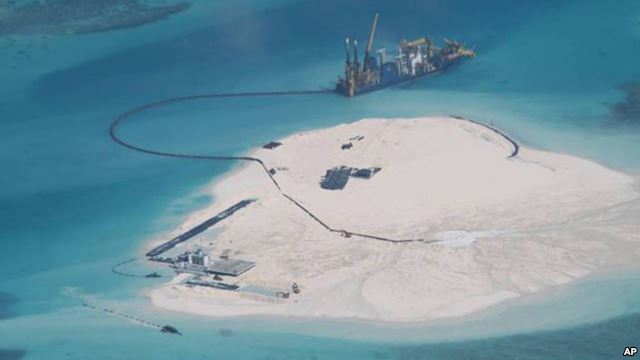VOA慢速英语: 中国在争议海域的活动引起美国和东南亚国家的恐慌
The United States and the Philippines have expressedconcern about China’s efforts to reclaim and developterritory in the South China Sea. But the Chinesegovernment is pushing forward. The government saysits activities are lawful and do not affect or target anycountry.
The U.S. Office of Naval Intelligence recently releaseda report about issues facing China and its neighbors at a time of a Chinese naval buildup. China is increasingits number of naval warships and submarines that carrymissiles.
The report notes that China is carrying out a major landreclamation effort around islands it controls in the SouthChina Sea. The report describes Chinese efforts todevelop an area near seven coral reefs in the SpratlyIslands. As a result of this activity, the amount of landhas expanded from about two hectares to more than300 hectares. There is now enough new land for atleast one runway for airplanes. The report says anotherairstrip could be ready by the end of this year.
Admiral Harry Harris heads the U.S. Pacific Command. He recently warned that China is building what hecalled a “great wall of sand” near the disputed islands. He also said how China acts in the future will decidewhether the South China Sea will be a place ofconfrontation or cooperation.
 |
|
FILE - In this Feb. 25, 2014 file photo taken by surveillance planes and released May 15 by the Philippine Department of Foreign Affairs, a Chinese vessel, top center, is used to expand structures and land on the Johnson Reef, called Mabini by the Philippines. (AP Photo/Philippine Department of Foreign Affairs, File) |
China says its goals are peaceful. But it does not denythe military or strategic value of its activities. It saysthe development of the islands could lead to moredetailed weather reports and improved safety forshipping in the South China Sea. It also says theislands could provide shelter for ships during severestorms.
Li Jinming is with the Center for Southeast AsianStudies at Xiamen University. He defends China’sactivities. He says China has not set up structures in the South China Sea as fast as other countries.
Professor Li says China is the only country that has an island in the areawithout an airstrip. He says no one criticized the Philippines and Malaysiawhen they built their runways. But now that China is building one, he says,neighboring countries are protesting.
In addition to the Philippines and Malaysia, Vietnam and Taiwan also haveairstrips on their islands in the South China Sea. Experts say Mr. Li is correctin noting that China has started the construction work later than othercountries. But they say China’s building program is much larger than that ofother countries.
China's maritime claims in the South China Sea
This week, Philippines officials estimated China’s construction activities havehurt fragile underwater reefs. They said countries around the South ChinaSea have suffered yearly losses of $100 million because of the damage.
China’s neighbors and the United States are worried about more than just theChinese construction. They criticize the way Chinese shipping has been usedto strengthen the country’s claims to parts of the South China Sea. Last year,China placed a large oil rig near the coast of Vietnam. It used water cannonsto keep Vietnamese ships from getting close to the equipment. The move ledto deadly anti-Chinese riots in Vietnam. Relations between the countries fell totheir lowest level in many years.
The area where China set up the oil rig was inside Vietnam’s 200-nautical mileeconomic zone. The zone was established under international law. Someobservers have asked whether Chinese officials are willing to obey the rulesor are trying to create their own.
China claims ownership of almost all of the South China Sea. It adds a line onmaps to help publicize that position. The line follows close to the coasts ofVietnam and the Philippines and reaches south to Brunei and Malaysia. Theline does not follow territorial borders set by international law. China has notyet said if the line means it believes it controls all of the waters or just theislands and reefs in the area.
Ye Qiang is an assistant research fellow at the National Institute for SouthChina Sea Studies. He says he believes the line shows China believes it hascontrol over islands and reefs and nearby waters.
He says the history of territorial disputes shows countries first demand morecontrol, then negotiate. He says it is important to watch how China deals withthe disputes.
I’m Christopher Jones-Cruise.
Bill Ide reported this story from Beijing. Christopher Jones-Cruise wrote it for VOA Learning English. George Grow was the editor.
______________________________________________________________
Words in This Story
reef – n. a long line of rocks or coral or a high area of sand near the surface of the water in the ocean
confrontation – n. a situation in which people or groups fight, oppose orchallenge each other in an angry way
strategic – adj. of or relating to a general plan that is created to achieve a goalin war or politics, usually over a long period of time; useful or important inachieving a plan or strategy
fragile – adj. easily broken or damaged
What is your opinion of China’s activities in the South China Sea? We want tohear from you. Write your thoughts in the comments section.
- 频道推荐
- |
- 全站推荐
- 推荐下载
- 网站推荐




















